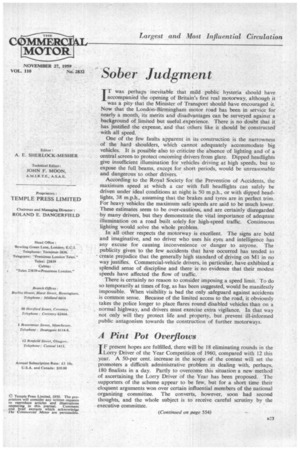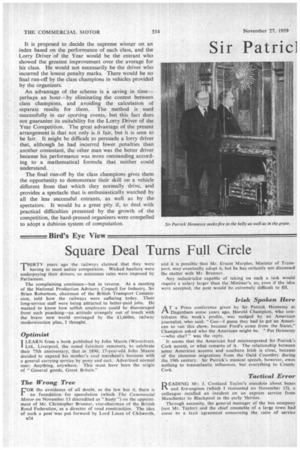Sober Judgment
Page 31

Page 32

If you've noticed an error in this article please click here to report it so we can fix it.
IT was perhaps inevitable that mild public hysteria should have accompanied the opening of Britain's first real motorway, although it was a pity that the Minister of Transport should have encouraged it. Now that the London-Birmingham motor road has been in service for nearly a month, its merits and disadvantages can be surveyed against a background of limited but useful experience. There is no doubt that it has justified the expense, and that others like it should be constructed with all speed. One of the few faults apparent in its construction is the narrowness of the hard shoulders, which cannot adequately accommodate big vehicles. It is possible also to criticize the absence of lighting and of a central screen to protect oncoming drivers from glare. Dipped headlights give insufficient illumination for vehicles driving at high speeds, but to expose the full beams, except for short periods, would be unreasonable and dangerous to other drivers. According to the Royal Society for the Prevention of Accidents, the maximum speed at which a car with full headlights can safely be driven under ideal conditions at night is 50 m.p.h., or with dipped headlights, 38 m.p.h., assuming that the brakes and tyres are in perfect trim. For heavy vehicles the maximum safe speeds are said to be much lower. These estimates seem to be over-cautious, and are certainly disregarded by many drivers, but they demonstrate the vital importance of adequate illumination on a road built solely for high-speed traffic. Continuous lighting would solve the whole problem. In all other respects the motorway is excellent. The signs are bold and imaginative, and no driver who uses his eyes and intelligence has any excuse for causing inconvenience or danger to anyone. The publicity given to the few accidents that have occurred has tended to create prejudice that the generally high standard of driving on MI in no way justifies. Commercial-vehicle drivers, in particular, have exhibited a splendid sense of discipline and there isno evidence that their modest speeds have affected the flow of traffic. There is certainly no reason to consider imposing a speed limit. To do so temporarily at times of fog, as has been suggested, would be manifestly impossible. When visibility is bad the only safeguard against accidents is common sense. Because of the limited access to the road, it obviously takes the police longer to place flares round disabled vehicles than on a normal highway, and drivers must exercise extra vigilance. In that way not only will they protect life and property, but prevent ill-informed public antagonism towards the construction of further motorways.
A Pint Pot Overflows
IFpresent hopes are fulfilled, there will be 18 eliminating rounds in the Lorry Driver of the Year Competition of 1960, compared with 12 this year. A 50-per cent. increase in the scope of the contest will set the promoters a difficult administrative problem in dealing with, perhaps, 180 finalists in a day. Partly to overcome this situation a new method of ascertaining the Lorry Driver of the Year has been proposed. The supporters of the scheme appear to be few, but for a short time their eloquent arguments won over certain influential members of the national organizing committee. The converts, however, soon had second thoughts, and the whole subject is to receive careful scrutiny by the executive committee. It is proposed to decide the supreme winner on an index based on the performance of each class, and the Lorry Driver of the Year would be the entrant who showed the greatest improvement over the average for his class. He would not necessarily be the driver who incurred the lowest penalty marks. There would be no final run-off by the class champions in vehicles provided by the organizers.
An advantage of the scheme is a saving in time— perhaps an hour—by eliminating the contest between class champions, and avoiding the calculation of separate results for them. The method is used successfully in car sporting events, but this fact does not guarantee its suitability for the Lorry Driver of the Year Competition. The great advantage of the present arrangement is that not only is it fair, but it is seen to be fair. It might be difficult to persuade a lorry driver that, although he had incurred fewer penalties than another contestant, the other man was the better driver because his performance was more outstanding according to a mathematical formula that neither could understand.
The final run-off by the class champions gives them the opportunity to demonstrate their skill on a vehicle different from that which they normally drive, and provides a spectacle that is enthusiastically watched by all the less successful entrants, as well as by the spectators. It would be a great pity if, to deal with practical difficulties presented by the growth of the competition, the hard-pressed organizers were compelled to adopt a dubious system of computation.
















































































































